Aristocrat Technologies Australia (ATA) v. International Gaming Technologies (IGT) (N.D.Cal. 2007).
ATA originally filed an Australian provisional patent application on July 8, 1997. Exactly one year later (on July 8, 1998) ATA filed its international PCT Application. In the US, a PCT applicant can wait 30 months to file its national stage application. ATA was actually given an extra two-days because the 30–month deadline of January 8, 2000 fell on a weekend.
Unfortunately, the January 10, 2000 deadline came and went — The PTO did not receive the national stage conversion until the next day January 11, 2000. By that time, however, the application had been abandoned.
Unable to Correct Filing Date without Proof of Mailing or PTO Receipt: ATA first asked the PTO to “correct” the filing date. This failed when ATA was unable to submit an express mail receipt or other direct proof of submission. The applicant did submit a certificate of mailing, a fee payment check, and a letter from the patent attorney that all indicated a January 10 filing date — these, however, did not pass muster with the PTO.
Revival for Missed National Stage: ATA was then able to revive the application by showing that the “entire delay” in filing the appropriate papers “was unintentional.”
During litigation, IGT challenged the PTO’s unintentional revival standard. In particular, 35 USC 371, which defines abandonment for failure to comply with national stage requirements, only allows for revival when a failure was “unavoidable.”
Failure to comply with these requirements shall be regarded as abandonment of the application by the parties thereof, unless it be shown to the satisfaction of the Director that such failure to comply was unavoidable. 35 USC 371.
The “unavoidable” standard is much higher than that for “unintentional” abandonment. And clearly, the applicant did not show that the delay was unavoidable.
Summary Judgment of Invalidity
For the foregoing reasons, the Court GRANTS Defendant’s Motion for Summary Judgment and finds that Defendants have shown, by clear and convincing evidence, that both patents in suit are invalid because the ‘215 Application was abandoned, and not lawfully revived.
Notes:
- This case has implications for Sections 371, 133 and 151.
- Statutory provisions for revival due to unintentional abandonment:
- 35 USC 111: Failure to submit fee and oath of a patent application;
- 35 USC 41: Fee schedule for revival of unintentionally abandoned applications. This section provides a specific fee for revival of unintentionally abandoned applications as an explicit alternative to revival of unavoidably abandoned applications; and
- 35 USC 122: Abandonment due to failure to rescind nonpublication request.
- Statutory provisions that only refer to revival due to unavoidable abandonment:
- 35 USC 133: Abandonment due to failure to respond to PTO notice (Normally a 6–month deadline, but may be less);
- 35 USC 151: Revival for failure to pay issue fee; and
- 35 USC 371: Failure to comply with national stage filing requirements.
- PTO Rules:
- 37 C.F.R. 1.137(b) provide for revival of applications based on an applicant’s unintentional delay in replying. Under the rule, abandoned applications, reexamination prosecution terminated under §§ 1.550(d) or 1.957(b) or limited under § 1.957(c), or lapsed patents may all be revived under this standard. The PTO rules are, however, subordinate to statutes.
- Caselaw:
- Lumenyte v. Cable Lite (Fed. Cir. 1996): Patentee had revived case as unintentionally abandoned. The CAFC affirmed the ruling without questioning whether such revival is ever permissible.
- Morganroth v. Quigg (Fed. Cir. 1989): Affirming that the Director does not have authority to revive an unintentionally abandoned patent application “that resulted from the applicant’s failure to appeal from a final district court judgment that upheld the Commissioner’s prior refusal to issue a patent.”
- New York Univ. v. Autodesk, Inc., 2007 U.S. Dist. LEXIS 50832 (SDNY 2007): The court found that the delay in reviving was not even unintentional. The court explicitly did not reach the question of whether revival for unintentional abandonment due to failure to respond to an office action is even permitted. (Remember, 35 USC 133 only allows for revival of unavoidably abandoned applications.)
- Field Hybrids v. Toyota (D.Minn 2005).
- Admin Law: There are a number additional admin-law issues in the case for those interested.
- Tech-Law-Forum discussess the case [LINK]
- Read the case [LINK]


 PATENT CONTINUATION AND CLAIMS RULES EXPECTED TO BE IN EFFECT IN OCTOBER — At a conference in New York yesterday, a speaker from the USPTO said the new patent rules on continuation applications and numbers of claims are expected to be published in August and in effect in October. IPO believes the rules are likely to be less severe than those that were published for comment in 2006.
PATENT CONTINUATION AND CLAIMS RULES EXPECTED TO BE IN EFFECT IN OCTOBER — At a conference in New York yesterday, a speaker from the USPTO said the new patent rules on continuation applications and numbers of claims are expected to be published in August and in effect in October. IPO believes the rules are likely to be less severe than those that were published for comment in 2006.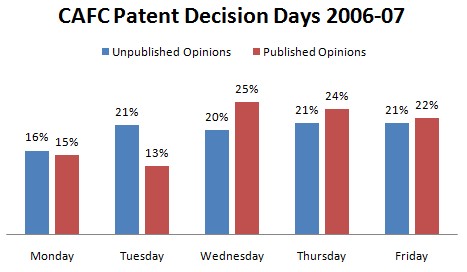

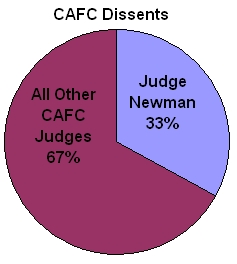 Over the past 25 years approximately 350 CAFC case decisions include dissenting opinions. Judge Newman is clearly the most prolific dissenter both in terms of absolute numbers and relative rate. Judge Newman has penned 115 of the dissents — 33% of the total, and her dissent rate per year on the court (4+) is almost double the nearest other judge. Judge Moore may be the rising alternative voice. In less than a year of service, she has already filed two dissents. (Source – Lexis search).
Over the past 25 years approximately 350 CAFC case decisions include dissenting opinions. Judge Newman is clearly the most prolific dissenter both in terms of absolute numbers and relative rate. Judge Newman has penned 115 of the dissents — 33% of the total, and her dissent rate per year on the court (4+) is almost double the nearest other judge. Judge Moore may be the rising alternative voice. In less than a year of service, she has already filed two dissents. (Source – Lexis search).  Cybersettle v. National Arbitration Forum (NAF) (
Cybersettle v. National Arbitration Forum (NAF) (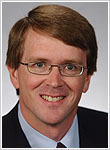 In his recent essay [
In his recent essay [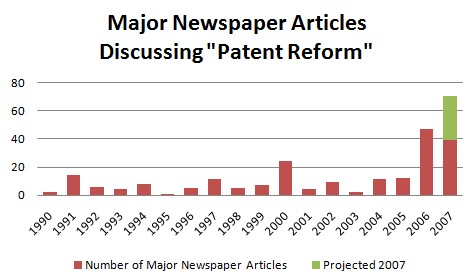
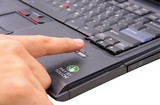 Ex parte Catan (
Ex parte Catan ( Two former Boston University Law School Colleagues occupied New York Times headlines on Sunday in a discussion of the economics of patent law. Michael Meurer and Jim Bessen are both economists and both law professors. Over the past few years, the pair has compiled a tremendous amount of economic data regarding patents and companies who patent.
Two former Boston University Law School Colleagues occupied New York Times headlines on Sunday in a discussion of the economics of patent law. Michael Meurer and Jim Bessen are both economists and both law professors. Over the past few years, the pair has compiled a tremendous amount of economic data regarding patents and companies who patent.  Meurer & Bessen do not suggest dismantling the patent system — rather, they believe that a number serious reform measures are needed to shift the balance back to a positive state where patents incentivize innovation.
Meurer & Bessen do not suggest dismantling the patent system — rather, they believe that a number serious reform measures are needed to shift the balance back to a positive state where patents incentivize innovation.